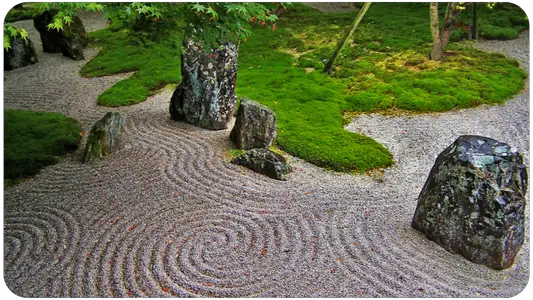The Mahabodhi Temple (Sanskrit: maha = great, bodhi = awakening) is a Buddhist temple in Bodhgaya in the northeastern Indian state of Bihar, originally built in the 2nd century.
On the west side of the temple is an offshoot of the poplar fig tree under which Siddhartha Gautama, the historical Buddha, according to tradition, attained awakening (bodhi). In June 2002, the temple was included in the UNESCO World Heritage List.
Location and architecture
The Mahabodi Temple is a 55-meter-high brick building dating from the 1st to 3rd centuries A.D. The exterior facade includes seven steps and is decorated with numerous Buddha statues.
The frieze that runs around the base of the temple on three sides features 85 sandstone Buddhas from the Sunga period (1st century BC). Inside the temple is a gilded statue of the meditating Buddha.
On the north side of the temple stretches the Jewel Path (Chankramanar), which consists of 19 stone lotus flowers marking the path where, according to tradition, Buddha practiced walking meditation in the second week after his Bodhi experience. The temple courtyard houses numerous stupas.
On the west side of the pyramid-shaped great stupa is the sacred Mahabodhi, a poplar fig (ficus religiosa, also known as the Bodhi tree), which according to tradition is a descendant of that tree under which Siddhartha Gautama attained Bodhi.
Under the Bodhi tree, the Diamond Throne (Vajrasana), a platform of red sandstone, marks the place where he had sat down to meditate.
History
Around 250 BC, the Buddhist ruler Ashoka visited Bodhgaya with the intention of creating a memorial site there. Ashoka had the Bodhi tree surrounded by a stone fence and marked the sacred place with an edict pillar with an elephant capital. Both are not preserved.
In the Sunga period, an open pavilion with stone pillars was built around the Bodhi tree, as well as the Diamond Throne. The Mahabodhi temple was built during the Kushana period in the 2nd century. The older part of the temple is made of sandstone.
In 625 the temple and also the original Mahabodhi tree fell victim to destruction during a war campaign of the Bengali king Shashanka. A little later, the younger part of the temple was rebuilt of rough granite.
The newly planted Mahabodhi tree at that time, which still exists today, is an offshoot of the Sri Mahabodhi in Anuradhapura (Sri Lanka), which in turn is a cutting of the original tree brought to Sri Lanka in the 3rd century BC by Sangamitta, the daughter of King Ashoka.
Around the year 635, the Chinese monk Xuanzang visited the temple during his pilgrimage and left a description of the site in his travelogue.
After destruction, the temple had to be fundamentally restored or rebuilt several times.
For centuries, the temple in Bodhgaya was one of the great Buddhist pilgrimage destinations, visited by monks from all those countries where Buddhism had spread. In the 12th and 13th centuries, restorations were carried out by Burmese, who also built the four small towers at the corners of the great stupa.
With the conquest of large parts of the Indian subcontinent by Muslim rulers (cf. Mughal Empire) beginning in the 12th century and the resurgence of Hinduism, the Mahabodhi temple eventually fell into oblivion and partially deteriorated.
It was not until the late 19th century that Buddhists, again from Burma, managed to agree with the British colonial rulers that the temple should be restored as a Buddhist shrine. Restoration work was completed in 1889.
Today's status
After India's independence in 1949, a committee was set up by the parliament to administer the shrine in conjunction with the Bihar government. The Temple Administration Committee, consisting of four Buddhists and four Hindus, first met in 1953.
In 1973, a complementary "Buddha Gaya Temple Advisory Board" was formed, consisting of 21 members from various nations.
Longstanding efforts by Buddhist monks to have a Buddhist chair the temple management committee initially failed due to the legal situation, as the Temple Management Act of 1949 stipulated that only a Hindu could chair the board.
Since an amendment to the Act in 2013, the head of the Gaya District is now allowed to head the committee, even if he is not a Hindu.
UNESCO inscribed the temple on the World Heritage List in June 2002.
On July 7, 2013, unknown persons carried out a multiple bomb attack on the Mahabodhi temple complex, which was sparsely visited that day, a Karmapa monastic school, and other targets in Bodhgaya.
Two monks were injured. The Indian Ministry of Home Affairs subsequently complied with a request from the Bihar government in August 2013 to provide special forces from the Indian Federal Police (CISF) to protect the UNESCO World Heritage site.
The Mahabodhi Temple is thus the only religious site in India to receive protection from special units of the federal police. In November 2013, the Indian government's National Investigation Agency announced that the Islamist terrorist group Indian Mujahidin was responsible for the attack.
The Indian government's National Investigation Agency announced that the attack was carried out by the Indian Mujahidin.





